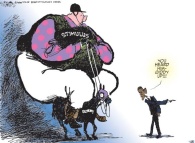Being a policy wonk in a political town isn’t easy. I care about economic libertywhile many other people simply care about political maneuvering. And the gap between policy advocacy and personality politics has become even larger in the Age of Trump.
One result is that people who should be allies periodically are upset with my columns. Never Trumpers scold me one day and Trump fanboys scold me the next day. Fortunately, I have a very simple set of responses.
- If you would have loudly cheered for a policy under Reagan but oppose a similar policy under Trump, you’re the problem.
- If you would have loudly condemned a policy under Obama but support a similar policy under Trump, you’re the problem.
Today, we’re going to look at an example of the latter.
The New York Times reported today on Trump’s advocacy of easy-money Keynesianism.
President Trump on Friday called on the Federal Reserve to cut interest rates and take additional steps to stimulate economic growth… On Friday,he escalated his previous critiques of the Fed by pressing for it to resume the type of stimulus campaign it undertook after the recession to jump-start economic growth. That program, known as quantitative easing, resulted in the Fed buying more than $4 trillion worth of Treasury bonds and mortgage-backed securities as a way to increase the supply of money in the financial system.
If I suddenly supported this approach under Trump, that would make me a hypocrite or a partisan.
I’m sure I have my share of flaws, but that’s not one of them.
 Regardless of whether a politician is a Republican or a Democrat, I don’t like Keynesian fiscal policy and I don’t like Keynesian monetary policy.
Regardless of whether a politician is a Republican or a Democrat, I don’t like Keynesian fiscal policy and I don’t like Keynesian monetary policy.
Simply stated, the Keynesians are all about artificially boosting consumption, but sustainable growth is only possible with policies that boost production.
There are two additional passages from the article that deserve some commentary.
First, you don’t measure inflation by simply looking at consumer prices. It’s quite possible that easy money will result in asset bubbles instead.
That’s why Trump is flat-out wrong in this excerpt.
“…I personally think the Fed should drop rates,” Mr. Trump said. “I think they really slowed us down. There’s no inflation. I would say in terms of quantitative tightening, it should actually now be quantitative easing. Very little if any inflation. And I think they should drop rates, and they should get rid of quantitative tightening. You would see a rocket ship. Despite that, we’re doing very well.”
To be sure, many senior Democrats were similarly wrong when Obama was in the White House and they wanted to goose the economy.
Which brings me to the second point about some Democrats magically becoming born-again advocates of hard money now that Trump is on the other side.
Democrats denounced Mr. Trump’s comments, saying they showed his disregard for the traditional independence of the Fed and his desire to use its powers to help him win re-election. “There’s no question that President Trump is seeking to undermine the…independence of the Federal Reserve to boost his own re-election prospects,” said Senator Ron Wyden of Oregon, the top Democrat on the Finance Committee.
Notwithstanding what I wrote a few days ago, I agree with Sen. Wyden on this point.
Though I definitely don’t recall him expressing similar concerns when Obama was appointing easy-money supporters to the Federal Reserve.
To close, here’s what I said back in October about Trump’s Keynesian approach to monetary policy.
I also commented on this issue earlier this year. And I definitely recommend these insights from a British central banker.
No comments:
Post a Comment